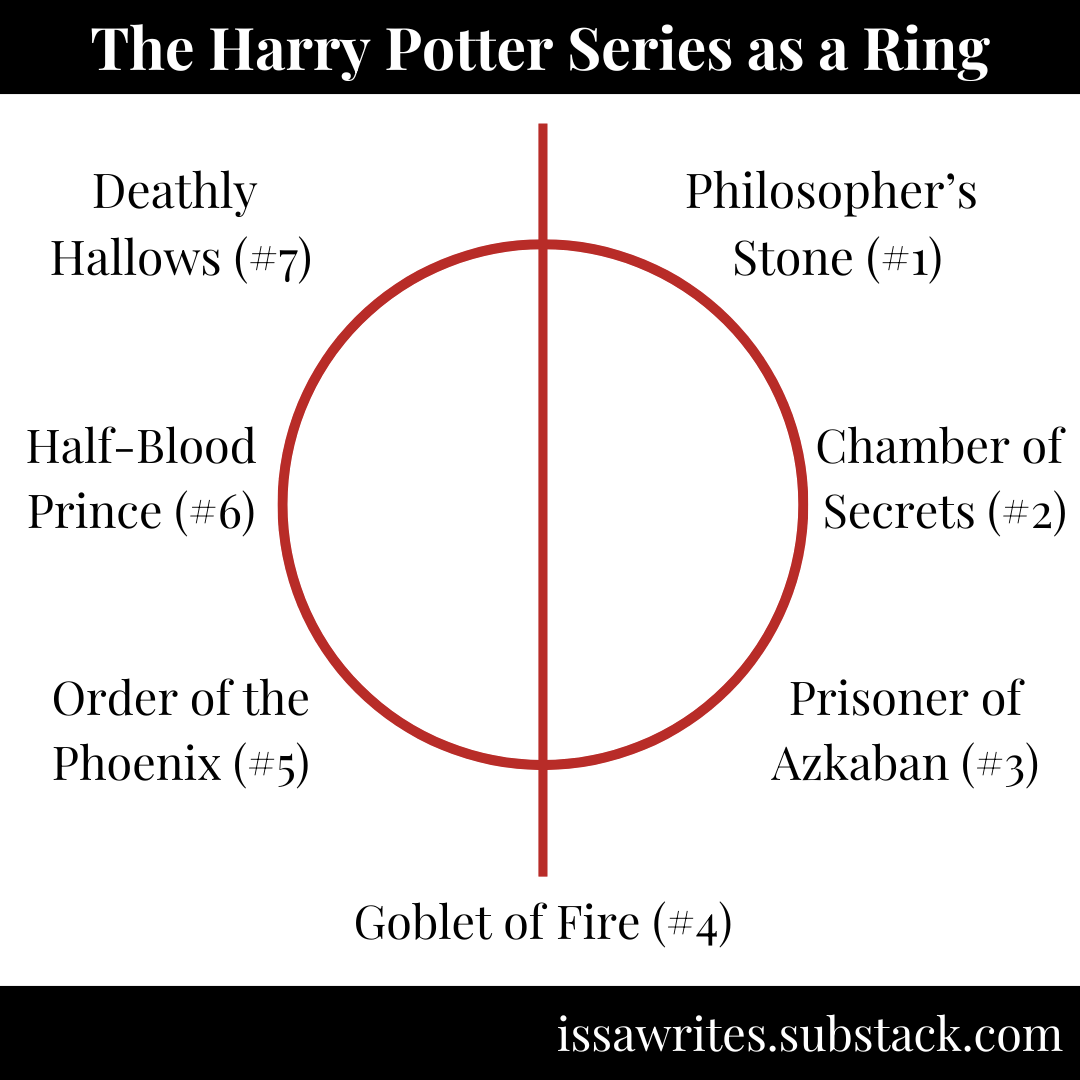Issa Writes 004a: Ring Structure Explained
A deep dive into the structure of the Harry Potter series
Today, we’re going to talk about story structure. You’ve probably heard of the three-act structure. Or the Hero’s Journey. Or Save the Cat.
These structures give you the scaffolding on which to build your story, a foundation that you know works because it’s been done over and over.
You fill in that scaffolding with your characters, your plots, your scenes, and your themes. You make it yours.
Today, I want to talk about a technique or structure I’ve found compelling since I first heard of it: ring structure, more properly called the chiastic structure.
What is it?
Ring structure is a classical narrative technique where story elements mirror each other:
The beginning mirrors the end, a few of the middle elements mirror each other, and there’s a clear midpoint where everything hinges.
Let’s talk about ring structure in the Harry Potter series, and then on Monday, I’ll give you a taste of how I’m using it in my book, The House on Adams Street.
Ring Structure in the Harry Potter Series
Here’s a visual of how the Harry Potter series uses ring structure:
The first book mirrors the last. The second and sixth mirror each other. The third and fifth mirror each other. And the fourth—the hinge—mirrors them all.
I wrote a thread on X that breaks down several examples, so I won’t rehash them here on Substack. You can read the thread here.
But I’m going to zero in on the main plot arc of the Harry Potter series: the first, fourth, and seventh books. If you think about it, you could remove all the others and still have a cohesive story:
Evil wizard tries to kill baby, but it doesn’t work, and he loses his powers. The boy grows up and learns he too is a wizard. Eventually, the evil wizard finds a way to come back. But the boy learns the keys to defeat the evil wizard and does.
Here’s a quick graphic showing a few of the similarities among the three books:
But these three books also illustrate one of the central themes of the series:
The power of sacrifice.
At the beginning of the series, Lily Potter willingly dies to save her son, granting him protection against Voldemort. At the end of the series, Harry Potter willingly dies to give his friends a chance to defeat Voldemort, only to return and defeat Voldemort himself.
So where do we see this theme in the fourth book, the center of the series?
In the fourth book, Harry has to complete three tasks in the Triwizard Tournament, meaning the Second Task is at the center.
In the Second Task, Harry and the other champions have to save captives from the merpeople at the bottom of a lake.
It seems simple enough:
Harry gets to the captives first and frees his captive. But he wonders where the other champions are. He waits. He wants to make sure everyone gets rescued. Eventually two other champions come to rescue their captives. But the final champion never appears. Against the merpeople’s wishes, Harry frees the last captive and swims to the surface, nearly drowning in the process. He ends up in last place.
What we see in the Second Task is a small echo of what Harry does at the end of the series:
He puts others’ needs before himself. He sacrifices winning first place in the Task to make sure everyone is rescued. And he put himself in danger of drowning.
Of course, the stakes in the Second Tasks weren’t that high. Everyone jokes that Harry should have realized that it was just a game and that the captives would’ve been saved regardless of what he did.
But the Second Task gave Harry a chance to foreshadow what he would do at the end of the series. It’s a bridge between his mother’s sacrifice at the beginning of the series and his sacrifice at the end of the series.
Still with me? Stay tuned for Monday, when you’ll see how I (nerdily) applied ring structure to my book-in-progress, The House on Adams Street.







